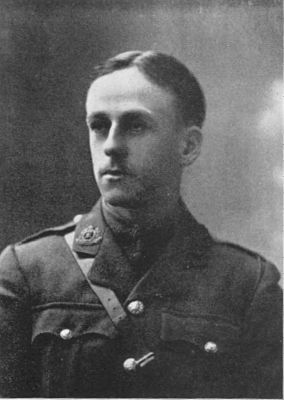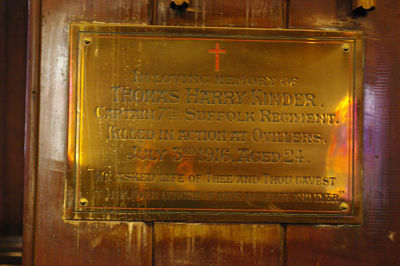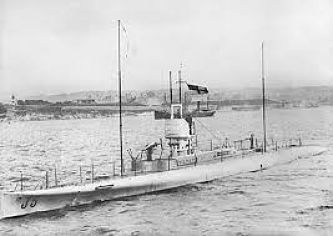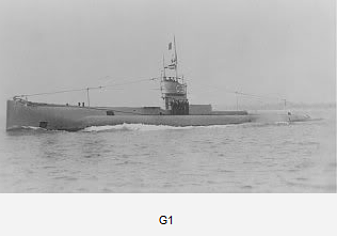WW1 Thomas Harry Kinder and John William Kinder
Thomas Henry (Harry) Kinder (British Army) was the second son of prominent Aucklander, Harry Allen Kinder.
Harry Allen Kinder (1868 – 1940), was a Manager at ASB Bank for many years, with an interest in local body and church affairs. Harry Allen Kinder had gifted paintings, that had been painted by his father, the Reverend John Kinder to the Auckland Art Gallery and South Pacific artefacts to the Auckland War Memorial Museum. Harry Allen Kinder married Emily Jane Kinder, (1868 – 1940) (nee Lodder) in 1882 and they lived at ‘Woodcroft’, 51 Arney Road, Remuera, Auckland. There were four children, Nesta Marianne (1886) (who married Percy Algernon Ferrier Watson in 1907), John William (1887), Dorothy Sarah (1891) who married George Shera. [1, 2}
Thomas attended King’s College in Auckland for a few months before attending Wanganui Collegiate for 8 years. Thomas was a keen sportsman, being Captain of the First Fifteen Rugby team in 1911. He was Head Prefect in 1912. He left Wanganui Collegiate at the same time as other students to attend Cambridge University. Thomas was studying at Caius College, Cambridge when war was declared. In 1915, Thomas was engaged to Miss Myra Shirtcliffe, [3], (Myra went on to marry in 1918, a war hero, Dr Garfield Crawford, who had been awarded a Military Cross for his bravery in working with the wounded, but she died in childbirth in 1920.)
At the outbreak of the war, Thomas volunteered for the King Edward’s Horse, The King’s Overseas Dominions Regiment, which was formed from ’men who were either born or had lived in the Colonies and were now residing in the United Kingdom’ [4] On learning that the King Edward’s Horse Regiment was ordered to Egypt, and as Thomas was anxious to go to France, he transferred to the Suffolk Regiment, 7th Battalion, where the Battalion was involved in various actions on the Western Front including; The Battle of Loos, The Battle of Albert, The Battle of Pozieres, and the Battle of Le Transloy.
In 1916, Thomas contracted scarlet fever whilst in the trenches and was invalided to England. On recovery, in June 1916, he again departed for the front and was promoted to Captain. The first Battle of the Somme began on 1 July 1916 and carried on until November 1916, with many battles fought to gain and lose parts of the Somme valley during those long months of fighting. There were so many losses on both sides including, Captain Thomas Henry Kinder of the 7th Suffolk Regiment, who was reported missing and subsequently reported ‘killed in action’ at the Somme, on 3rd July 1916 aged 24. [5, 6, 7]
Thomas was awarded the 1914-1915 Star, British War Medal (1914-1920) and the Victory Medal. Thomas’s name is on the memorial in Thiepval Memorial, Authuile, Somme, France, which was described by Thomas Swinburn at the Remuera Heritage Christmas 2016 speech: which remembers all those who died on the Somme without any known grave. Somewhere on this enormous plaque were Remuera men Thomas Kinder and Richard Gutteridge, which just goes to show the scale of the loss. [8] Thomas is remembered by an obituary at Wanganui Collegiate School, a Memorial plaque at St Mark’s Anglican Church, 95 Remuera Road, Remuera, Auckland, and St Heliers School. King’s College remembers him by a window in the King’s College memorial chapel, a large silver and enamel shield awarded for shooting competitions and in the College’s Roll of Honour.
John William Kinder (M8857)
Thomas Henry Kinder’s older brother, John William Kinder (M8857) was born 22nd September 1887, also attended Wanganui Collegiate College. After leaving school, he trained and worked at George Frasers and Sons Engineers in Christchurch. Later he went to Sydney and became a Chief Engineer.
A desire to obtain some knowledge of oil engines took him to England, and ships. He was sailing between England and the Argentine on a vessel called the ‘Highland Pride’ when war was declared. Immediately he offered his, services and John joined the British Navy on 18 September 1914, as a Marine Engineer. Later he was promoted to Chief Engine Room Artificer Class 2. John was attached to a first-class cruiser ‘The Penelope’. On board this vessel, he spent a winter on patrol in the North Sea after which he volunteered for submarine duty. [1,2,3,4]
He joined the Submarines at HMS ’Dolphin’ on 29th May 1915 and spent time serving on a number of vessels; the HMS ‘Maidstone’, ‘Dolphin’, ‘Titania’ and HM Submarines ‘J6’ and ‘G1’. He was Mentioned in Despatches for bravery (London Gazette 2nd November 1917) and demobilized 17 February 1919. [2]
After the war, John was for many years, resident engineer with the Auckland Hospital. In 1962, he died aged 82. [5]



